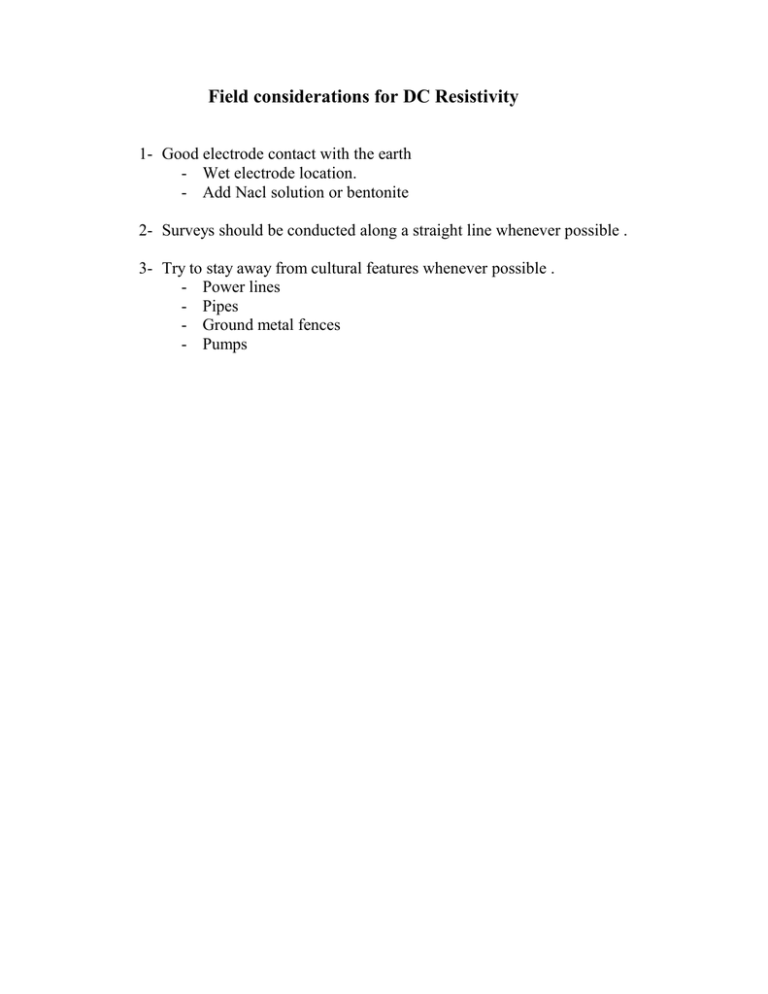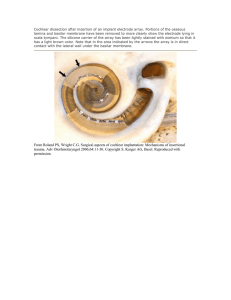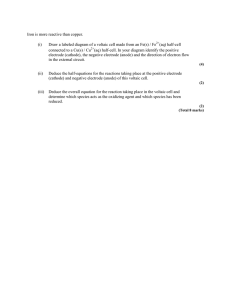Field considerations for DC Resistivity
advertisement

Field considerations for DC Resistivity
1- Good electrode contact with the earth
- Wet electrode location.
- Add Nacl solution or bentonite
2- Surveys should be conducted along a straight line whenever possible .
3- Try to stay away from cultural features whenever possible .
- Power lines
- Pipes
- Ground metal fences
- Pumps
Sources of Noise
There are a number of sources of noise that can effect our measurements of
voltage and current.
1- Electrode polarization.
A metallic electrode like a copper or steel rod in contact with an
electrolyte groundwater other than a saturated solution of one of its own
salt will generate a measurable contact potential. For DC Resistivity, use
nonpolarizing electrodes. Copper and copper sulfate solutions are
commonly used.
2- Telluric currents.
Naturally existing current flow within the earth. By periodically reversing
the current from the current electrodes or by employing a slowly varying
AC current, the affects of telluric can be cancelled.
3- Presence of nearby conductors. (Pipes, fences)
Act as electrical shorts in the system and current will flow along these
structures rather than flowing through the earth.
4- Low resistivity at the near surface.
If the near surface has a low resistivity, it is difficult to get current to flow
more deeply within the earth.
5- Near- electrode Geology and Topography
Rugged topography will act to concentrate current flow in valleys and
disperse current flow on hills.
6- Electrical Anisotropy.
Different resistivity if measured parallel to the bedding plane compared to
perpendicular to it .
7- Instrumental Noise .
8- Cultural Feature .
Current Flow in A Homogeneous Earth
1.
Point current Source :
If we define a very thin shell of thickness dr we can define the potential
different dv
dv = I ( R ) = I ( ρ L / A ) = I ( ρ dr / 2π r2 )
To determine V a t a point . We integrate the above eq. over its distance
D to to infinity :
V = I ρ / 2π D
C: current density per unit of cross sectional area :
2. Two current electrodes
To determine the current flow in a homogeneous, isotropic earth
When we have two current electrodes. The current must flow from the
positive ( source ) to the resistive ( sink ).
The effect of the source at C1 (+) and the sink at C2 (-)
Vp1 = i ρ / 2π r1 + ( - iρ / 2π r2 )
Vp1 = iρ / 2π { 1/ [ (d/2 + x ) 2 + Z2 ]0.5 - 1 / [ (d/2 - x )2 + Z2 ]0.5 }
3. Two potential Electrodes
Vp1 = i ρ / 2π r1 - iρ / 2π r2
Vp2= i ρ / 2π r3 - iρ / 2π r4
Δ V = Vp1 –Vp2 = i ρ / 2π ( 1/r1 – 1 / r2 – 1 / r3 + 1 / r4 )
Depth of Current Penetration
Current flow tends to occur close to the surface. Current penetration can be
increased by increasing separation of current electrodes. Proportion of current
flowing beneath depth z as a function of current electrode separation AB:
Example
If target depth equals electrode separation, only 30% of current flows beneath
that level.
•
To energize a target, electrode separation typically needs to be 2-3 times
its depth.
•
High electrode separations limited by practicality of working with long
cable lengths. Separations usually less than 1 km.
The fraction of the total current (if) penetrating to depth Z for an electrode
separation of d is given by :
if = 2 / π tan -1 ( 2 Z / d )
ELECTRODE CONFIGURATIONS
The value of the apparent resistivity depends on the geometry of the
electrode array used (K factor)
1- Wenner Arrangement
Named after wenner (1916) .
The four electrodes A , M , N , B are equally spaced along a straight line. The
distance between adjacent electrode is called “a” spacing . So AM=MN=NB=
⅓ AB = a.
Ρa= 2 π a
V /I
The wenner array is widely used in the western Hemisphere. This array is
sensitive to horizontal variations.
2-
Lee- Partitioning Array .
This array is the same as the wenner array, except that an additional
potential electrode O is placed at the center of the array between the
Potential electrodes M and N. Measurements of the potential difference are
made between O and M and between O and N .
Ρa= 4 π a
V /I
This array has been used extensively in the past .
3) Schlumberger Arrangement .
This array is the most widely used in the electrical prospecting. Four
electrodes are placed along a straight line in the same order AMNB , but with
AB ≥ 5 MN
AB 2 MN 2
−
V
2 2
ρa = π × ×
I
MN
This array is less sensitive to lateral variations and faster to use as only
the current electrodes are moved.
4. Dipole – Dipole Array .
The use of the dipole-dipole arrays has become common since the 1950’s
, Particularly in Russia. In a dipole-dipole, the distance between the
current electrode A and B (current dipole) and the distance between the
potential electrodes M and N (measuring dipole) are significantly smaller
than the distance r , between the centers of the two dipoles.
ρa
2
=π[(r
/ a ) – r ] v/i
Or . if the separations a and b are equal and the distance between the
centers is (n+1) a then
ρa
= n (n+1) (n+2) . π a. v/i
This array is used for deep penetration ≈ 1 km.




